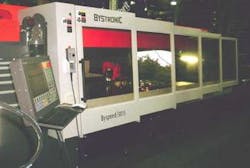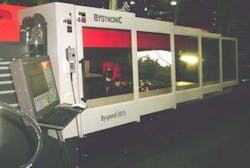Investing for the turnaround
It's relatively easy to plan for capital equipment expansion when the economy is booming, as it was in 2000. It's another matter to not cancel equipment orders when that economy tanks, as it did in 2001. And it's rather gutsy to take delivery of new capital equipment in 2002 when the economy had yet to show signs of recovery. And yet companies do, especially those who show foresight in planning how they will be positioned when the recovery occurs. In the job shop sector where company owners, usually hands-on managers, are betting their own money on new equipment purchases, the decision to go ahead with an equipment delivery is a wrenching one. And that's why this writer has such admiration for these small business owners.
Two outstanding examples of fabricating shop owners who have gambled on near-term recovery in the job shop market can be found in California. Especially interesting is that both of these companies are located in a state that is not known as being business friendly, as evidenced by the flood of small and medium-sized companies relocating to Utah, Nevada and Arizona and those going international to Mexico and China.
Sonoma Metal Products Inc. (Santa Rosa, CA) and Laser Tech (Chino, CA), located at opposite ends of the state, are fabricating shops with similar capabilities, serving different customers, many of which are also feeling the effects of the economic slowdown plaguing U.S. manufacturing companies. The common thread tying these shops together in this article is that both are laser job shops and both had the foresight to install the latest equipment, the Bystronic Byspeed high-speed, 4kW laser cutter. In fact, these companies took delivery of the first two Byspeeds installed in the U.S. ILS previewed this laser system last May in a User Profile of the first Byspeed installation at a Swiss job shop, Laserjet 2000.
null
Serge Parsadaian immigrated to the U.S. in 1977, locating in the Los Angeles area with relatives. Because of his background in sheet metal fabricating, he took a job with a major fabricating shop located in City of Industry. While working at this company he took the route many incipient entrepreneurial-oriented newcomers do by working as a machine shop, nights, in his garage workshop. With the money saved from his moonlighting he started his own fabricating business in 1989, locating in City of Industry.
Before startup, Parsadaian decided that his shop would be centered around the newly developing laser cutting technology, because he saw this as the future direction sheet metal cutting would take. His reasoning was that the laser's lack of tooling, especially special tooling with long fabrication times, was a plus in shortening turnaround time, an experience gained from the shop where he worked. This was an example of his foresightedness, which manifested itself again last year when he gambled on purchase of a new laser in the depths of an industry recession.
Laser Tech started business in a marketplace not used to laser cutting of sheet metal. Indeed, the company was the first laser-only shop in the Los Angeles area, a uniqueness that took a lot of selling on Parsadaian's part. His first unit, a 1kW hybrid beam/workpiece motion system, gave him the capability to cut both cold-rolled and stainless steel, on a rapid response basis, thereby drawing new customers. Adding another of these laser units in 1991, the company was running on a two-shift basis. Further additions of press brakes and forming and welding equipment made the shop a full-service fabricator, predating a trend that is currently sweeping the industry.
With the addition of a water-jet cutting machine, Parsadaian found the City of Industry site, now comprising three 4500-ft2 buildings, was becoming too restrictive. Offered an attractive deal in Chino at half the square-foot cost, in 1997, Parsadaian moved Laser Tech to the 27,000-ft2 facility it now occupies. As part of the move, the company added a new large-bed Bystronic 4020 laser cutter. In 2000 a Bystronic Bystar 3015 4kW unit was added, followed by the 4kW Byspeed in 2002. The original hybrid machines are still used for special jobs.
null
Today Laser Tech runs a single shift, because of the current economic slowdown in Southern California. Prior to this, the company had been servicing customers over a wide geographic area, including some back East. Now its current market is within a 100-mile radius of the facility, composed of diverse industries with cutting jobs in both sheet metal and plate, the latter a capability the 4kW machines can handle.
Parsadaian bought the Byspeed not specifically for its fast cutting speed. As he says, he can match this speed on his other 4kW Bystronic. What attracted him was the Byspeed's rapid motion system, which means he can process more parts faster. "It's motion, not speed," he says when explaining this unit's advantage.
With the current recession, Laser Tech will take any type of cutting job, being more competitive because of the rapid turnaround time and 4kW capabilities. Still, the company runs only one shift with an occasional overtime. Parsadaian does his own cost estimating and finished job cost analysis. Non-metal cutting is also offered, usually using the old hybrid machines. Quantities can range from 1 to 100,000 parts, in both sheet and plate. The Bystar offers a fourth axis, so tube cutting is offered.
Parsadaian, like many other shops, is feeling the effects of the lengthy economic slowdown, which has reduced the number of customers and caused several of his current customers to stretch payments. And yet echoing the reason he came to the U.S. and why he started his own business, he remains optimistic. As he says, "It takes too much energy to be pessimistic."
Up in Sonoma County, Brian Herndon runs Sonoma Metal Products (SMP), a full-service fabricating and wireform company he started in 1985. The company began as a fabricator of wire shelves, baskets and frames using wire forming, bending and welding equipment, which was supplemented in 1988 with a turret punch to produce the tabs and brackets used to assemble wire frame chassis with components and covers. With the first turret punch in Santa Rosa, the company began to draw customers for sheet metal parts and soon realized that it now had a new direction for growth.
This led to the implementation of new CNC fabricating equipment, including, in 1993, the company's first laser, a "sheet dragger," which is a machine designed with a fixed cutting head and moving x/y table. Herndon decided that it would be more efficient and cost effective to perform all his customers' laser-cutting applications in-house rather than sub-contracting to others. This proved to be true as he had this unit booked solid in three month's time, running two shifts.
Learning about new linear motor laser cutters, which offered higher cutting speed, Herndon traded the sheet dragger for one of these, which was installed in mid-1997. This machine was a 2kW hybrid gantry-style laser cutter, which featured one of the industry's first PC controllers. He quickly found that this unit could compete effectively with his turret punches, especially in processing stainless steel and thicker cold-rolled steel parts.
This unit was supplemented, in January 1998, with another new hybrid gantry-style laser cutter, with a 3kW laser and a conventional machine controller. This addition offered the capacity to cut thicker steel and aluminum. With these units, SMP ran 24/5 as business in the Bay Area boomed, especially in the high-tech telecommunications area, which became a major customer.
Herndon found that the linear motion system, with its PC controller, competed directly with his turret punches, while turning out high-quality work in a shorter turnaround time. This laser cutter, with its linear motor motion system and PC controller, actually cut two to three times faster than the later unit because it's PC control provided a look-ahead feature that enabled faster cutting of contoured parts and more complex nesting.
Always trying to utilize state-of-the-art equipment, Herndon kept aware of advances being made by laser systems suppliers. This led him to evaluate the 4kW machine in 2001 and to select and purchase a Bystronic Byspeed, which was installed in May of 2002—right at the depth of the economic downturn. He selected this unit for its cutting and processing speed, which he rates as 50-percent faster than the linear motion system and four times as fast as the hybrid machine. Consequently, he sold off the latter.
SMP serves about 100 customers actively from a base of more than 300. These represent the telecommunications, computer and medical industries that are located in the greater San Francisco Bay area. Although located in the wine country, the company has few customers from that industry, perhaps because their metal cutting demands are limited. While watching the Byspeed in operation we saw a stainless-steel grape leaf being cut for a local restaurant. However, with the addition of the 4kW capability, Herndon expects more business in plate thick section cutting. He already has seen some response from the area's agricultural industry and is cutting a significant amount of plate in the 1/4 to 1/2 inch range and some up to one-inch thick.
SMP remains a full-service shop, employing 70 people on a single-shift schedule to fabricate sheet metal and wire parts. Welding is a big part of what the company does, and 17 heliarc welding stations take up a chunk of the super-clean and well laid out 50,000-ft2 shop floor.
To estimate for new jobs SMP uses two full-time and one part-time estimators. Estimating is key to SMP's success, and it uses a company-modified commercial software package. On the other hand, job cost analyses is only important when SMP bids repeat jobs. Herndon figures that his people are good enough to get it right the first time. On the shop floor laser operators select the jobs and group them by cutting gas. Because they use clean dry shop air for cutting both stainless and carbon steels, the company only buys nitrogen in tanks. Thus, the operators gang the day's cutting program by the type of gas used, to minimize setup time. Currently they cut 50 percent cold-rolled steel and 50 percent stainless and aluminum, with one operator running two machines with the assistance of a loader.
Business is currently slow, although some telecommunications business seems to be coming back. As a result, a second shift is used only when necessary. The Byspeed was bought to be in place when the expected recovery occurred later this year. Right now Herndon is concerned about his timing. When the recovery happens, he plans to replace one of the three turret punches with another laser cutting system. Sitting in his office Herndon wistfully looks at a photo of his Bonanza airplane, which is hangered at the adjacent airport. He speaks wistfully of moving to Reno, but you know this is only a passing thought as he plans to take his company to new levels when the turnaround happens.
Although located some 400 miles apart, Laser Tech and Sonoma Metal Products reflect today's situation in the fabricated metal business. However, both companies, led by visionaries, have gambled that when the recovery happens they will be best positioned to compete with the other laser cutters in the area. They placed their bets on a high-speed 4kW laser cutter and are already seeing the wisdom of that decision.
California companies have the option of contacting Laser Tech ([email protected]) or Sonoma Metal Products (www.sonomametal..com). For more detaILS on the Bystronic Byspeed, contact the company at www.bystronic.com.


